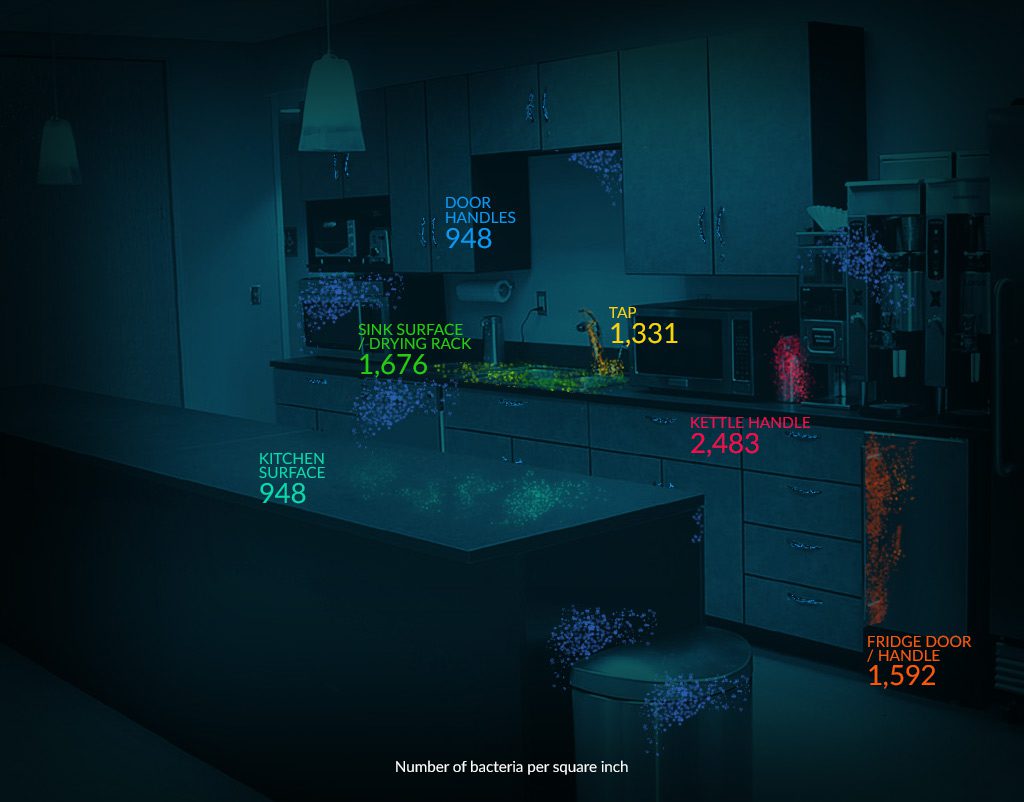Germs in the Workplace
Whether simply a runny nose or the full-blown flu, illness can be extremely frustrating and is certainly not a situation you would wish on your friends or co-workers.
Despite that, in a survey of 1,000 office workers, it was found that over two-thirds of workers do not follow recommended office hygiene guidelines for how often to clean or sanitize their workspace.
Germs lurking on your office phone, other office equipment, and other office surfaces touchpoints are quite a prevalent issue, with two in three workers becoming ill after being exposed to the spread of germs by everyone in the office.
However, one in ten employees admit to only cleaning their desk once a month, and a further 9% said their workstation never gets disinfected. Hygiene negligence can eventually add up, making the office a hotspot for nasty germs.
We won’t tell you exactly what types of germs are collected in a typical office, because you’ll never want to return to the office ever again, but we can tell what the top germ hotspots in the office are.
Dirtiest Places in the Average Office
Phone – 25,127 germs per square inch
One of the largest breeding grounds for germs, and unfortunately, a feature that you can rarely avoid touching, is your phone.
While it is impossible to get rid of all these bacteria completely, you can help to stem the increase by performing regular cleaning of your phone handset with antibacterial wipes or spraying at least once a week.
Chairs – 21,000 germs per square inch
You’ve probably never questioned how many germs may be sitting alongside you on your office chair, but the answer is an incredible amount. This count will include both the seat and arms of your chair, so you can’t escape the risk of picking up germs.
You should aim to vacuum your office chair at least once a week and give it a deeper clean around once a month, which will not only leave it feeling fresher but reduce the build-up of bacteria and viruses. How you clean your chair will depend on its type of upholstery fabric so be sure to check for cleaning instructions on the furniture tags to avoid any damage.
Keyboard and mouse – 3,295 germs per square inch and 1,676 germs per square inch
Your hands will be at your keyboard most of the day, passing germs onto the keys, where they can then stay and breed. When you then pick up food and drinks, this can be quite a risk for your health. To prevent illness or infection, you should aim to clean your keyboard once a week, or every time you eat at your desk.
To clean, disconnect the keyboard from your computer and wipe with a damp microfiber cloth or anti-bacterial wipe. Be sure to clear out any dust or crumbs from beneath the keys with a can of compressed air.
Alongside your keyboard, your computer mouse is one of your desktop items that will gain the most use throughout the day. While using it to navigate your computer, you will be passing hordes of bacteria between the mouse and your hands, which you can then pass onto other communal objects and vice versa.
To avoid this transfer of bacteria, you should aim to clean your mouse once every three weeks, making it harder for germs to settle and breed. To clean, simply wipe the mouse with a sanitizing wipe.
Desktop – 20,961 germs per square inch
Since your desk is where you spend a great deal of time at work, you should give it priority cleaning. Your desktop is not only home to your essential office items and stationary, but to a whole host of bacteria and diseases.
The average desk harbors about 400 times more bacteria than the average toilet seat, with some of these bacteria types being incredibly harmful and contributing to the spread of germs.
Survey data shows that almost a fifth of offices are cleaned once a month or less. This makes it easy for undesirable bacteria to breed.
As you are likely to place everything on your desk at some point, whether it be your mobile phone, your pens, or even your food, the bacteria here can pose quite a danger. Letting your desk become a breeding ground for germs means that you accidentally expose yourself to illness and disease, simply by doing your job.
The common cold is easily spread around an office, so it may be in your best interests to begin taking control of the germs in your work area.
A simple way to do this is to clean your desk at least twice a week. You probably don’t want the commercial cleaning crew touching anything on your desktop, so you should consider keeping some disinfecting wipes nearby so you can do it yourself.
Fridge door handle – 1,592 germs per square inch
Your fridge, which keeps all your food fresh is the last place you would want bacteria to form.
Avoid a barrage of germs by giving the outside of your fridge a wipe with an antibacterial cleaner each week. Throw away open food containers, wipe the inside at least once a week to stop any unpleasant odors or germs, and schedule a deep cleaning of entire the refrigerator every three months.
Faucet – 1,331 germs per square inch
Though you may use the faucet to clean other items, it is easy to forget that the tap itself may need cleaning from time to time.
If you avoid doing this for too long, a build-up of bacteria can occur and threaten the hygiene levels of your office kitchen.
Sink / Drying rack 1,234 germs per square inch
As with your faucet, your sink surface and drying rack can get visibly grimy if not properly maintained. Along with this, bacteria and germs can begin to spread.
To keep the number of germs down, and your kitchen a safe environment to prepare food and drink, you should thoroughly clean the tap and sink once a day with a disinfecting cleaner. The drying rack should be cleaned at least once a week.
Kitchen Countertop – 948 germs per square inch
Your kitchen surface is used for preparing meals, with various forms of raw and cooked food, as well as cutlery, touching it throughout the day. If you fail to keep this surface clean, you may be laying your lunch on a bed of bacteria.
Kitchen surfaces should be cleaned with a microfibre cloth or antibacterial wipe at the end of each day to reduce the risk of illness.
Utensils drawer handle – 754 germs per square inch
The utensils drawer handle will be touched by pretty much everyone who uses the kitchen, it is not a surprise that employees’ hands can then pass germs onto them. These germs will then be picked up by the next person to touch this, aiding the spread of bacteria and illness.
Along with all other handles and surfaces, this should be wiped over with a microfiber cloth or antibacterial wipe at the end of each day to reduce the risk of illness.
Water cooler – 2.7 million germs per square inch
Your water cooler will not only provide you with precious hydration but a whole swarm of germs and bacteria. As this feature is used by every member of your office on breaks throughout the day, it is crucial that the area is thoroughly cleaned with antibacterial wipes to keep germ counts down.
The Importance of Proper Office Hygiene
This is a startling statistic, and it highlights the importance of proper hygiene in shared office spaces. It’s important to advise everyone in the office to wash their hands regularly for at least 20 seconds and wipe down common surfaces like:
- Coffee pot and coffee maker
- Microwaves
- Kitchen Appliances
- Water dispensers
- Copier and photocopier buttons
- Desk phones
- Door handles
Additionally, having a commercial cleaning company clean and disinfect regularly can help reduce the number of germs found on these surfaces.
What are the best ways to help keep your staff safe?
Professional cleaning companies can create a targeted hygiene program to help employers and facility managers safeguard workers by concentrating cleaning and disinfection efforts on the areas with the highest level of germs. In addition, a regular cleaning schedule will improve the air quality and provide a fresh office environment.
High-touch areas such as keyboards and elevator buttons present a distinct problem when it comes to sanitizing since those are irregular surfaces being touched that provide numerous places for germs to hide and must be given special consideration.
In addition, the frequency of cleaning must be given special consideration for common area hotspots – for example after a meeting has taken place in the conference room. If cleaning staff can’t clean before and after every meeting, disinfecting products can be placed in the conference room for employees to use to help protect themselves and their co-workers.
Furthermore, the frequency of sanitation must be taken into account for high-traffic areas – for instance after a meeting in the conference room. Most likely, the office cleaning crew cannot clean before and after each meeting, or after someone uses the kitchen and restroom, so disinfectants can be provided around the hotspots in the office for employees to use as a way to reduce the spread of germs themselves and their colleagues.
Remember that professional cleaning companies do this day in and day out, they have the right cleaning supplies, including EPA-approved, green alternatives, and they know how to clean efficiently.
NAE Cleaning Solutions can provide a wide array of services to help you keep your staff safe and healthy. Call us now to schedule a free walkthrough.
Source: https://www.printerland.co.uk/germs-in-your-firm-E412.aspx

